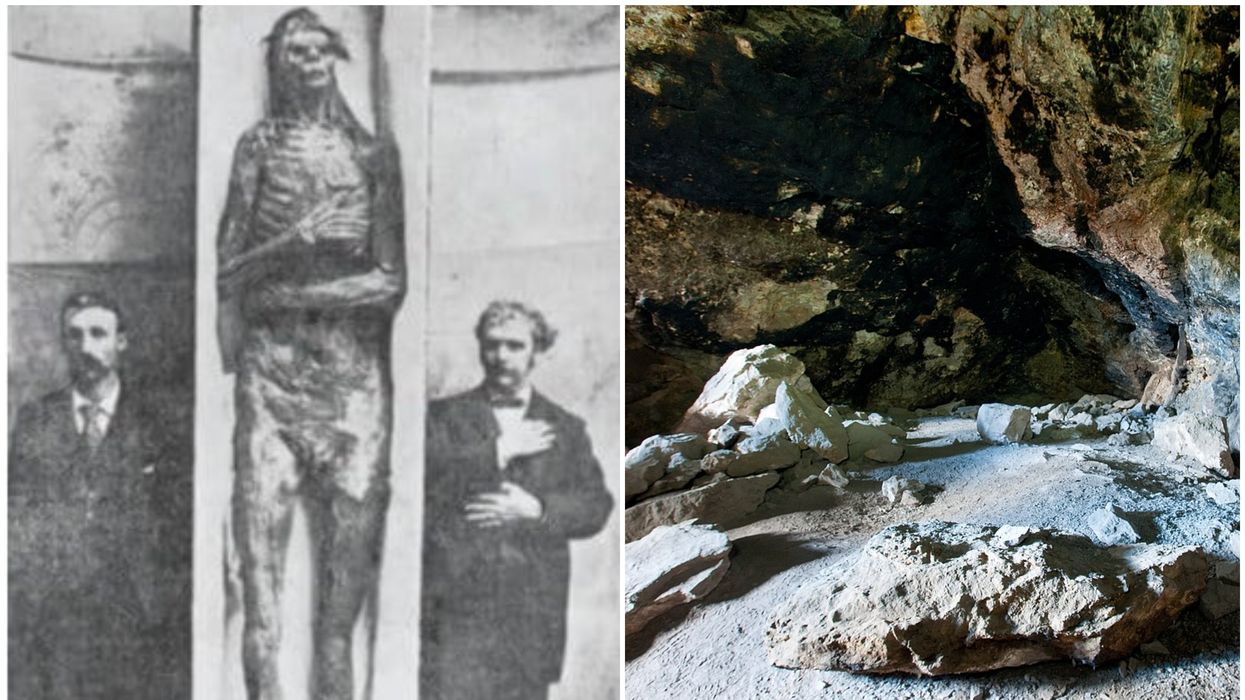Harriet Brewis
Jun 25, 2024

The so-called Lovelock Giants were unearthed in a cave in Nevada
(Free License via History Channel/Flickr)
Mythology, folklore and even the Bible tell us that giants once roamed the Earth. And, it turns out, there’s evidence to back this claim.
Extraordinary human remains have been found in the US state of Nevada, with some of the skeletons measuring up to 10 feet tall.
Alongside their jaw-dropping size, the bodies – some of which were said to have been mummified – were found to have had red hair.
This has fuelled the theory, passed down through the ages, that a long-forgotten race of humans once dominated southwestern America.
According to the Paiute, a tribe that settled in the Nevada region thousands of years ago, cannibalistic, red-haired giants called the Si-Te-Cah came to the Americas from a distant island.
Legend has it that the Si-Te-Cah crossed the ocean on rafts made of reeds, and they soon made a name for themselves as being taller, stronger and crueller than ordinary men.
Then, in 1911, while digging for bat guano (a key ingredient in fertilizer) in a cave near the city of Lovelock, Nevada, some miners unearthed a number of strange objects.

This prompted the launch of two official excavations in 1912 and then in 1924, during which thousands of artefacts were recovered.
Among the staggering finds were the mummies, nicknamed the Lovelock Giants, which measured between 8 and 10 feet tall, according to Archaeology World.
They also found 15-inch-long sandals that showed signs of wear and a boulder etched with what appears to be a giant handprint.
Shortly after the second excavation, in 1931, an article published in local newspaper the Nevada Review-Miner, claimed that two giant skeletons had been discovered in a dry lake bed close to Lovelock.
These remains measured 8.5 and 10 feet in height respectively, and were mummified in a manner similar to that employed by the Ancient Egyptians.
And while all of this may sound far-fetched, the legend of these strange people crops up all over the Americas.
For example, in the sixteenth century, a Spanish conquistador, called Pedro Cieza de León, recorded an ancient Peruvian tale about the giants’ origins.
In his account, de León wrote that the towering figures “came by sea in rafts of reeds [in] the manner of large boats” and that “some of the men were so tall that from the knee down they were as big as the length of an ordinary fair-sized man.”

Furthermore, high up in the Andes, between Peru and Bolivia, skeletons with elongated skulls have been found.
The remains are said to be around 3,000 years old and much larger than normal human ones.
Intriguingly, some of them were also found to have red hair.
According to Archaeology World, some scientists attribute this reddish colour to the environment in which the bodies were buried.
However, others view it as proof of the existence of the Si-Te-Cah and their kin.
And if you’re wondering how such a strong and monstrous race came to disappear if indeed it ever existed at all, the Paiute have the answer.
According to their mythology, the Si-Te-Cah waged war on them and all other neighbouring tribes, wreaking terror and destruction.
After years of fighting, the tribes united against this formidable foe.

Eventually, the last remaining giants were chased away and sought shelter inside Lovelock cave.
Seizing their chance, the tribes started a fire at the cave entrance, suffocating and burning alive the few Si-Te-Cah who were left.
Interestingly, when the initial discoveries were made at the cave back in 1911, evidence of extreme burning near its entrance was found, the History Channel reports.
And even if these 10-foot giants are just a figment of folklore and fertile imaginations, it’s still fun when all the threads of the story come together.
Sign up for our free Indy100 weekly newsletter
Have your say in our news democracy. Click the upvote icon at the top of the page to help raise this article through the indy100 rankings
Top 100
The Conversation (0)













